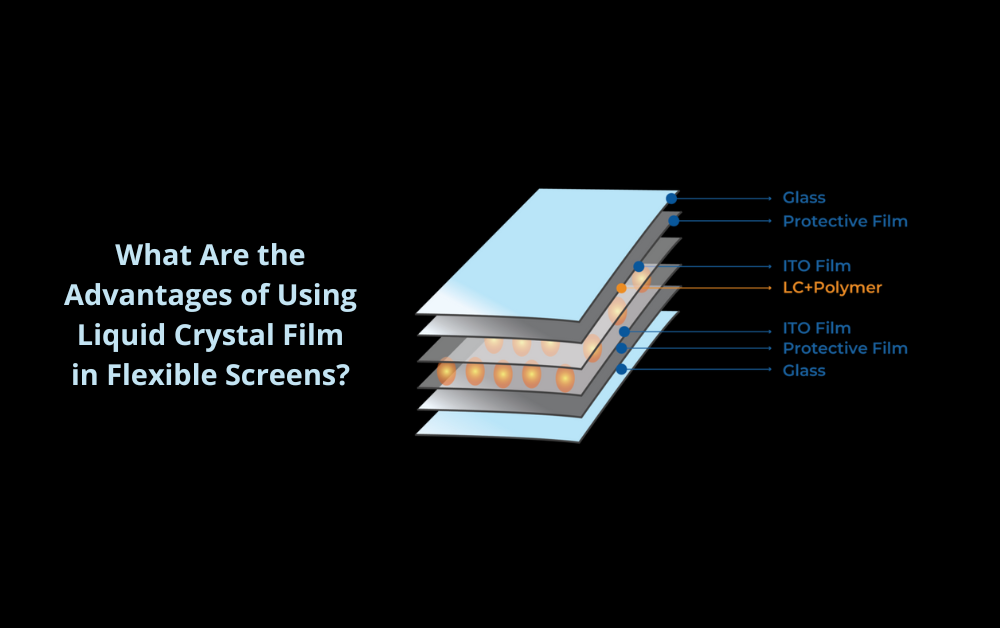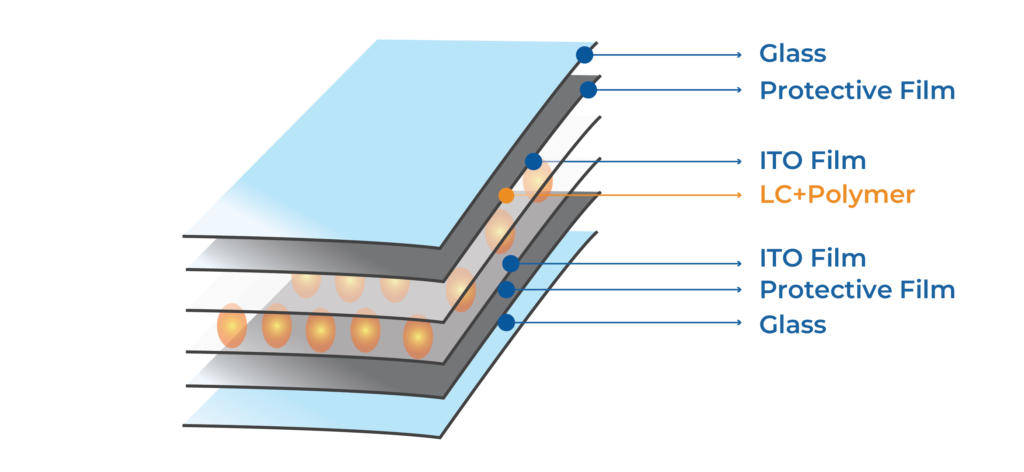
Technology is evolving at an incredible pace, and one of the most exciting areas of innovation is flexible screens. These screens can bend, fold, and twist, making them perfect for a range of new applications, from foldable smartphones to wearable devices. A key component that makes these flexible screens possible is Liquid Crystal Film (LCF). But what exactly is Liquid Crystal Film, and what are the advantages of using it in flexible screens? Let’s dive into the details.
What is Liquid Crystal Film?
Liquid Crystal Film (LCF) is a type of material that contains liquid crystals, which are substances that have properties between those of conventional liquids and solid crystals. Liquid crystals can flow like a liquid but have some properties of a solid, like their ability to align in a structured way. This unique combination of properties makes liquid crystal films highly useful in electronic displays, especially in flexible screens.
How Does Liquid Crystal Film Work?
Liquid crystals in the film can be controlled by electric fields. When an electric current passes through the film, it changes the orientation of the liquid crystals. This change in orientation can alter the way light passes through the film, which is how images and colors are displayed on screens. The ability to control light in this way makes Liquid Crystal Film an essential component in the display technology used in flexible screens.
Note :- Ready to Experience the Future of Display Technology? Discover the incredible potential of Liquid Crystal Film in your next project. Whether you’re looking to innovate with flexible screens or explore the possibilities of smart glass in Dubai, there experts are here to help. Contact smart glass dubai today to learn how Liquid Crystal Film can transform your designs into cutting-edge solutions!
The Rise of Flexible Screens

Flexible screens have become a significant trend in recent years, and they are expected to revolutionize the way we interact with electronic devices. Unlike traditional screens, which are rigid and fragile, flexible screens are designed to be more durable and adaptable. They can be folded, rolled up, or bent without breaking, which opens up a world of possibilities for new gadgets and devices.
Examples of Devices with Flexible Screens
- Foldable Smartphones: These are smartphones that can be folded in half, making them more compact and portable. When unfolded, they provide a larger display area, similar to a tablet.
- Wearable Devices: Smartwatches, fitness trackers, and even some types of clothing are being designed with flexible screens. These devices can conform to the shape of the body, making them more comfortable and functional.
- Rollable TVs: Some companies are developing televisions that can be rolled up like a piece of paper. These TVs can be stored away when not in use, saving space in your home.
- E-Readers and Tablets: Flexible screens are also being used in e-readers and tablets, making these devices lighter and more durable, perfect for reading on the go.
Why Use Liquid Crystal Film in Flexible Screens?
The use of Liquid Crystal Film in flexible screens offers several advantages. Let’s explore these benefits in more detail.
1. Flexibility and Durability
One of the most significant advantages of Liquid Crystal Film is its flexibility. Unlike traditional screens that can crack or break when bent, LCF allows screens to bend and flex without damage. This makes the screens much more durable and resistant to physical stress. Devices with flexible screens are less likely to break when dropped or subjected to other forms of impact, which is a huge benefit for everyday use.
2. High-Quality Display
Despite the flexibility, Liquid Crystal Film does not compromise on display quality. It can produce bright, sharp images with vibrant colors, which is essential for a good viewing experience. Whether you are watching videos, playing games, or browsing the web, screens made with LCF offer excellent clarity and color accuracy. This high-quality display is critical for ensuring that flexible screens are not just a novelty but a practical and functional technology.
3. Energy Efficiency
Liquid Crystal Film is also known for its energy efficiency. It requires less power to operate compared to other types of display technologies. This is because LCF can maintain the orientation of its liquid crystals with minimal power, reducing the overall energy consumption of the device. For portable devices like smartphones and wearables, energy efficiency is crucial because it directly impacts battery life. With LCF, these devices can last longer on a single charge, making them more convenient for users.
4. Lightweight Design
Another advantage of using Liquid Crystal Film in flexible screens is that it is lightweight. This is important because it allows for the creation of devices that are easy to carry and handle. Whether it’s a foldable phone that fits comfortably in your pocket or a wearable device that you barely notice on your wrist, the lightweight nature of LCF contributes to the overall user experience. It’s one of the factors that make flexible screens practical for everyday use.
5. Improved Viewing Angles
Liquid Crystal Film also offers improved viewing angles compared to traditional screen technologies. This means that the screen can be viewed clearly from different angles without the image becoming distorted or losing brightness. This is particularly important for devices like smartphones and tablets, where users often view the screen from various angles. With LCF, users can enjoy a consistent viewing experience no matter how they hold their device.
6. Versatility in Design
The use of Liquid Crystal Film allows for greater versatility in design. Because the material is flexible, it can be used to create screens of various shapes and sizes. This opens up new possibilities for product design, enabling manufacturers to create devices that were not possible before. For example, screens can be curved to fit the contours of a wearable device, or they can be designed to fold into different configurations for a smartphone. This versatility is one of the reasons why flexible screens are considered the future of display technology.
7. Environmental Impact
The production and use of Liquid Crystal Film can also have a positive impact on the environment. Since LCF-based screens are more durable and energy-efficient, they contribute to a reduction in electronic waste and energy consumption. Additionally, the lightweight nature of LCF means that less material is used in the production of devices, further reducing the environmental footprint. As the world becomes more conscious of sustainability, these factors make LCF an attractive option for manufacturers and consumers alike.
The Future of Liquid Crystal Film in Flexible Screens
The future of flexible screens looks bright, and Liquid Crystal Film is set to play a crucial role in this evolution. As technology continues to advance, we can expect to see even more innovative uses for LCF in flexible screens. Here are some trends to watch out for in the coming years.
1. Expansion of Flexible Display Applications
As the technology behind Liquid Crystal Film and flexible screens continues to improve, we can expect to see these screens used in a wider range of applications. Beyond smartphones, wearables, and TVs, flexible screens could be integrated into everything from car dashboards to smart home devices. The possibilities are endless, and as more industries recognize the benefits of flexible screens, the demand for Liquid Crystal Film is likely to increase.
2. Enhanced Durability and Performance
Researchers and manufacturers are continuously working on improving the durability and performance of Liquid Crystal Film. This could lead to the development of even more robust and long-lasting flexible screens. Future iterations of LCF could offer better resistance to extreme temperatures, moisture, and other environmental factors, making flexible screens even more reliable and versatile.
3. Cost Reduction and Accessibility
As with any new technology, flexible screens and Liquid Crystal Film are currently more expensive to produce than traditional screens. However, as the technology matures and production processes become more efficient, the cost of LCF is expected to decrease. This will make flexible screens more accessible to a broader range of consumers, potentially leading to widespread adoption across various markets.
4. Integration with Emerging Technologies
The integration of Liquid Crystal Film with other emerging technologies is another exciting prospect. For example, combining LCF with advanced touch-sensitive materials could lead to the development of highly responsive flexible touchscreens. Additionally, as augmented reality (AR) and virtual reality (VR) technologies evolve, LCF could be used to create immersive, flexible displays that enhance the user experience.
5. Collaboration Between Industries
The development and implementation of Liquid Crystal Film in flexible screens are likely to benefit from collaboration between various industries. Display manufacturers, tech companies, and materials scientists will need to work together to push the boundaries of what is possible with LCF. Such collaboration could lead to the creation of new standards and best practices that further accelerate the adoption of flexible screens in the market.
Conclusion
Liquid Crystal Film is a game-changing material that is helping to drive the evolution of flexible screens. Its unique properties, such as flexibility, high-quality display, energy efficiency, and lightweight design, make it an ideal choice for modern electronic devices. As technology continues to advance, we can expect to see even more exciting developments in this field, with Liquid Crystal Film playing a central role in shaping the future of display technology.
The advantages of using Liquid Crystal Film in flexible screens are clear. From enhancing durability to enabling innovative product designs, LCF is paving the way for a new generation of electronic devices. Whether it’s foldable smartphones, wearable gadgets, or rollable TVs, the potential applications for flexible screens are vast, and the impact on our daily lives could be significant.
As we look to the future, it’s exciting to imagine the possibilities that Liquid Crystal Film and flexible screens will bring. With ongoing research and development, the technology will likely become even more advanced, leading to new products and applications that we can’t yet envision. The era of flexible screens is just beginning, and Liquid Crystal Film is at the heart of this revolution.
Note :- Read more related blogs at small biz blog